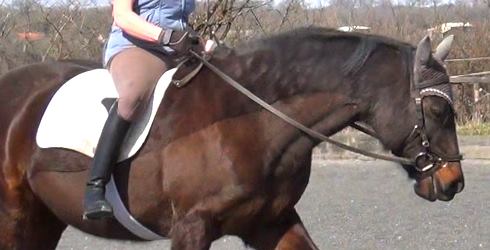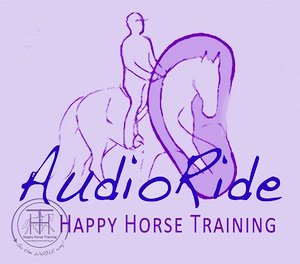Forget Bitless, What About Saddle-less?
If you are going to argue for bitless then you have to argue for
saddle-less too. The argument being that if any equipment we use can
cause harm to the horse then it must be rejected.

In my experience of Craniosacral Therapy, working with horse ailments
and injuries, I would say that there are certain hotspots for pain and
discomfort in the ridden horse.
There is no doubt that one of those is
the horse's head. Mostly from tooth imbalances and neck injury from
gadgets and front-end riding. The horses back is way up there too, and
although there can be no true calibration of any of it, I would hazard a
guess that more horses suffer from their back damage than their mouth.
Narrowing that down, there is a lot of damage from plain old bad
training - poor seats, unprepared horses, horses too young and too weak,
and forceful riding techniques.
There is also a VAST amount of damage
caused by ill-fitting and poorly designed saddles. At least the majority
of ridden horses have cartilage damage in their scapulae. Can you
imagine the pain of a saddle forcing into your shoulders every stride to
the point of your shoulder blades wearing away? And someone up there
insisting that you keep going?
If a saddle ever comes anywhere near our
horses shoulders, they make sure we know about it in a couple of strides,
they don't have to tolerate it because we make sure it doesn't happen,
or sort it out straight away if it does. So because there is a chance of
this happening does that mean everyone has to start riding bare-back
with a pad?
The thing is that there isn't a simple line that has
been drawn in life which says this side is 'good' and that side is
'bad'. We all draw our own lines because we all have our own reasons for
what we believe. There are certain pieces of equipment that we don't
use at HHT because firstly we believe they are used for the wrong
intentions, and secondly because we think it is almost impossible to use
them in a non-forceful way anyway. Those would include draw-reins,
double bridles, spurs and saddles with metal in the tree.
The way
that we have decided that about each of these things was from hearing it
from the horses in many different ways. How they feel in their systems
through energy work sensing, how they react, how they have been
traumatised in the past, how they are to ride, how they progress in
their training from month to month and year to year etc. It is all a
process of discovery, and we believe in our answers because we have
worked hard for them. We also know that they are not the whole picture.
There is always more to understand.
The important thing is to stay
in each moment and listen to what happens in that moment. In the photo
above, Ardeche was being ridden with a numnah because she didn't like her
saddle at the time. It was a saddle made with her in mind, wide enough
and one of the most sophisticated, ergonomic saddle on the market, yet
she didn't want it. So she didn't have it on. At other times of her life
she went bit-less because she didn't want a bit, and at the time of
this photo it happens that she was happy with the bit. Because the bit
gives us a more sensitive connection with the horse we like using them.
When pain and tension are involved there can be no training, so if bits
equaled pain we simply wouldn't use them.
The most difficult thing
to do is to have the patience and the open-mindedness to listen to the
horse's opinion, and to make that compatible (somehow!) with your own
opinion, and to do that every moment you are with your horse. It's not
always going to work perfectly but making 'rules' and thinking that you
then don't have to connect with it anymore is not the answer. Rules like
'I ride my horse bit-less so he is fine now' or 'I got my saddle fitted
by an expert so it is fine now' or 'I got my horse 'checked out' and
she has no pain'.
If your horse tells you they have a problem then
they have a problem. Rules don't exist in the present moment, and that
is where we have to be to connect with horse.
For a full explanation of why we prefer to use bits in our training approach, see this backissue of The Whole Horse newsletter.
Return from Forget Bitless, What About Saddle-less to the Happy Horse Training homepage.
The pages on HHT are so wide-ranging and interrelated that we strongly recommend you look at the site plan to find other subjects that may interest you.
New from HHT!
AudioRide is a series of exercises designed to listen to while you ride.
Audio descriptions guide you through each step of developing a balanced, dynamic connection with the horse through your position.
This truly innovative learning tool gives you a whole new way of being guided in your riding, in a calm, clear, step-by-step way.
Free Download! Introductory Exercise: Riding in the Now
The Gymnastic Rider eBook
Now available exclusively from HHT!
A unique, comprehensive guide to practical rider biomechanics. This professionally produced eBook takes the rider through the process of developing their body in the specific way that brings the horse's movement into harmony and balance, without force and constraint. Click here for full details, and to download the 15-page introduction to the book for free.
Join the Happy Horse Training group on Facebook!
See and share topical info, news and photo's, and take part in lively discussions.
Click here to go to the HHT group (make sure you log into fb first) and then click on the 'join' button at the top of the page.
Join the Whole Horse Newsletter!
HHT's free monthly newsletter giving you wide-ranging and intelligent insights into holistic horsemanship.
Just enter your details below to join.
Free bonus on the riding position with all new subscriptions: Ten Top Tips To Instantly Improve Your Connection With Your Horse.
Click here to see back issues of The Whole Horse newsletter
Train Your Horse
The Holistic Way
How To Train A Horse Without Force
is a unique guide to training horses through energetic connection and
gymnastic training. Part 1 covers everything on the ground, from
handling to the lungeing technique that develops strength, straightness
and engagement. Comes with a free eBook supplement on Horse Trauma.
Click here for more details.
"As a student of Zen Buddhism for nearly three decades, I've often wondered when someone was going to write the book on Zen and the art of horsemanship, and I think that your emphasis on mindfulness and energy connection gets right at the heart of the matter."
- Prof. Teresa Lloyd, U.S.
Do You Have
A Horse Story
To Share On HHT?
So many people have been through
wonderful experiences with horses, whether in training or otherwise. If
you've made a change in a horse's life - or one has made a change in
yours - tell us about it here.
Learn The Natural Barefoot Trim - The Simple Way
The Simple Seven-Step Natural Trim is a comprehensive step-by-step guide to a cutting-edge barefoot trim. Click here to find out more.
What people say about HHT:
"The riding instruction is outstanding, if instructors in the UK taught this way there would be a lot of happy riders and horses."
"The riding tuition exceeded my hopes and expectations by a long way; giving me an exciting new facet to horsemanship which is lighter. more subtle, more elegant and more meaningful. It is as if a new door has opened bringing more sunlight and air."
"My goodness - what a change has taken place in my riding. I think that I'm starting to sit 'into' the horse rather than on top of him. I felt my horse's movements in a way that has almost never happened before"
Click on Testimonials for more










New! Comments
Anything to say about this page? Leave your comment in the box below.